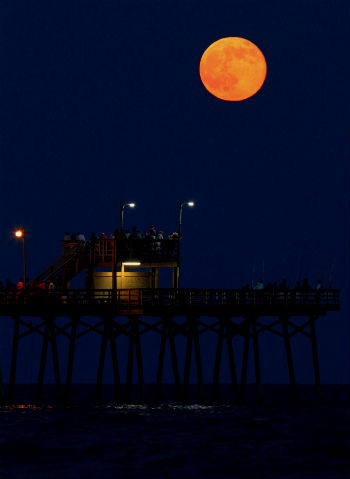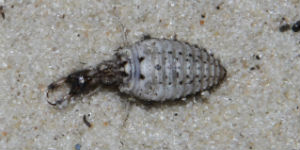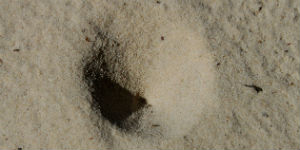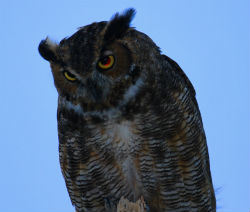 The full moon rises above Bogue Inlet Pier in Emerald Isle earlier this month. It appears larger than normal because it is closer to the Earth, hence the name “supermoon.” Full moons in July were nicknamed “Thunder Moon” and “Buck Moon” by the Native Americans. Photo: Sam Bland The full moon rises above Bogue Inlet Pier in Emerald Isle earlier this month. It appears larger than normal because it is closer to the Earth, hence the name “supermoon.” Full moons in July were nicknamed “Thunder Moon” and “Buck Moon” by the Native Americans. Photo: Sam Bland |
EMERALD ISLE — Each month I eagerly anticipate the arrival of the new full moon. I don’t know what it is, but mysterious urgings cause me to wander outside to find an open landscape and patiently wait for the luminous orb to silently glide into the night sky making its grand entrance.
The recent full moon of July was hyped up by the media as a “supermoon” because it was a bit brighter and appeared somewhat larger than normal. I didn’t like the use of the word because I thought it was conjured up by the media to sensationalize their coverage of this flashy full moon.
Supporter Spotlight
 The supermoon above Bogue Inlet Pier. Photo: Sam Bland The supermoon above Bogue Inlet Pier. Photo: Sam Bland |
So, I was surprised to learn that the term “supermoon” is rooted in astrology and was first used in 1979 to describe a full moon (or a new moon) that occurs when the moon is closest to the earth, which is called perigee. Now, any qualified astronomer would not be caught dead using the term supermoon. Instead, they would properly refer to this phenomenon as a perigee-syzygy. But this is a bit too stuffy for me, so supermoon will do just fine.
Super or not, viewing the full moon from the beach as it reflects the light of the sun onto the splashing waves of the ocean has an effect on just about everybody. When you mix the beach, the ocean and a supermoon, I think anybody could become a moonstruck, loony lunatic. So I decided to head out to the beach to figure out why the full moon has such a pull on people just as it does the tides.
I arrived at the beach just in time to see the “Thunder Moon” peek above the horizon. Native Americans referred to the July full moon as the Thunder Moon due to the frequency of thunderstorms during July. They also named it the “Buck Moon” because the male deer are now displaying the growth of new velvety antlers.
The moon seemed to move quickly into the sky, revealing a soft orange ball. Some of the beach strollers suddenly stopped in their tracks and excitedly pointed at the moon in utter amazement, obviously unaware that the evening would feature a full moon. It was a breathtaking sight that is best described by a quote from comedian George Carlin: “There are nights when the wolves are silent and only the moon howls.”
The romance of the moon was taking its toll as most of the couples on the beach were walking hand-in-hand, some shared kisses and long blissful hugs. The moon has long been a symbol of fertility as horseshoe crabs and corals rely on the full moon to trigger their reproductive activities.
Supporter Spotlight
I hiked over to a section of sand dunes sprouting a fresh growth of sea oats and noticed a few things that were reacting to the fullness of the moon. A marsh rabbit was busy nibbling on some vegetation under the concealment of a wax myrtle shrub, wary to venture out into the open. The full moon could just as easily be a spotlight alerting a great horned owl to its presence. Some species of reef fish also stay out of sight during the brightest period of the full moon to hide from predators. Out in the open dune valley I could see that the ant lion sand traps were noticeably bigger than usual to snare insects that are more active during a full moon.
 Ant lions are insects that build cone-shaped pits into which their prey, especially ants, fall. Photo: Sam Bland Ant lions are insects that build cone-shaped pits into which their prey, especially ants, fall. Photo: Sam Bland |
 Sam noticed that the ant lion sand traps were noticeably bigger than usual to snare insects that are more active during a full moon. Photo: Sam Bland Sam noticed that the ant lion sand traps were noticeably bigger than usual to snare insects that are more active during a full moon. Photo: Sam Bland |
Even though it was a steamy July summer night, I was surprised by the number of people on the beach. I wasn’t the only one magnetized by the beach and moon. I paused at the base of the dune and watched as narrow flashlight beams swept across the beach as children searched for ghost and mole crabs at the edge of the surf. With the sun well under the horizon, people were still swimming and body surfing under the glow of the moon. Looking down the beach, the harsh light of an old school Coleman lantern silhouetted the whipping motion of a surf rod as a fisherman cast his hope for a fish into the frothy waves. Even the hiss of the lantern could be heard as it floated down on a breeze.
As I walked on the open beach, sand castles built under the warmth of the day’s sun were being erased by the incoming tide. Just one wave flattened the turrets and walls created by plastic molds and washed away all evidence of the fortress except for the laughter and memories of those that built it. Each high tide prepares a new slate to document the activities of a new day etched in the sand.
After watching the people revel on the beach and ocean under the full moon, I understood the beautiful tranquility — the sand, the breeze, the waves, the salt air – has to relax and calm of the soul. This is why so many people celebrate weddings, reunions, vacations and birthdays at the shore. The dynamic nature of the ocean is reflected in its many moods that capture our attention; but there seems to me that there must be more.
What is it that makes people stare out into the ocean and contemplate for hours? No stranger to the sea, Jacques Cousteau once said, “The Sea, once it casts its spell holds one in its net of wonder forever.” Many times in my life I have sought the refuge of a special place on a barrier island when I needed to reflect or hit the reset button. No matter what the cause of my concerns, things seemed to always fall into perspective. For me, heading to the beach during a full moon is almost an instinctual migration of the soul and spirit.
With the moon now high in the sky, I slowly began to meander off the beach while stealing last glances of the moon that was now a more silver color than orange. The dry, loose sand was squeaking under my bare feet as I walked to one of the wooden boardwalks.
 The full moon acts as a spotlight on the prey of the great horned owl. Photo: Sam Bland The full moon acts as a spotlight on the prey of the great horned owl. Photo: Sam Bland |
From a distance, I could see the figure of a woman sitting on the last step of the boardwalk stairs. Her legs were drawn up to her chest and her head and arms were resting on her knees. I could see that her shoulders were shaking as she was crying. In the sand at her feet was a tall glass candle vase along with a picture frame. As I got closer, I could catch glimpses of a woman’s smiling face as the dancing candle flame softly illuminated the frame. When I reached the steps I paused momentarily, to offer what, I don’t know. So deep into her sorrow, she was oblivious to my presence and I tip-toed up the stairs and headed down the boardwalk through the dunes. I couldn’t help but to think that she was finding comfort in the beach and the moon- splashed ocean as she grieved for a friend.
Once behind the primary dune line, the sound of the spilling waves ceased as if someone had closed a door. Yet, there was no silence, as my ears were now filled with the familiar high-pitched sound of a summer beach night, the chorus of cicadas and katydids. At the end of the boardwalk, two blurry blue objects were streaking towards me as I heard children giggling and the slapping of bare feet on the wooded planks. In a flash, two young kids, maybe three to four years old, ran past me, one on each side, gripping blue glow sticks in each hand. With their laughter drifting into the night, they raced before their parents towards the shimmery ocean and into the sticky embrace of the salt spray suspended in the warm summer air.
Then it hit me. We shouldn’t ponder too much about the things we love; we need to just enjoy them.







